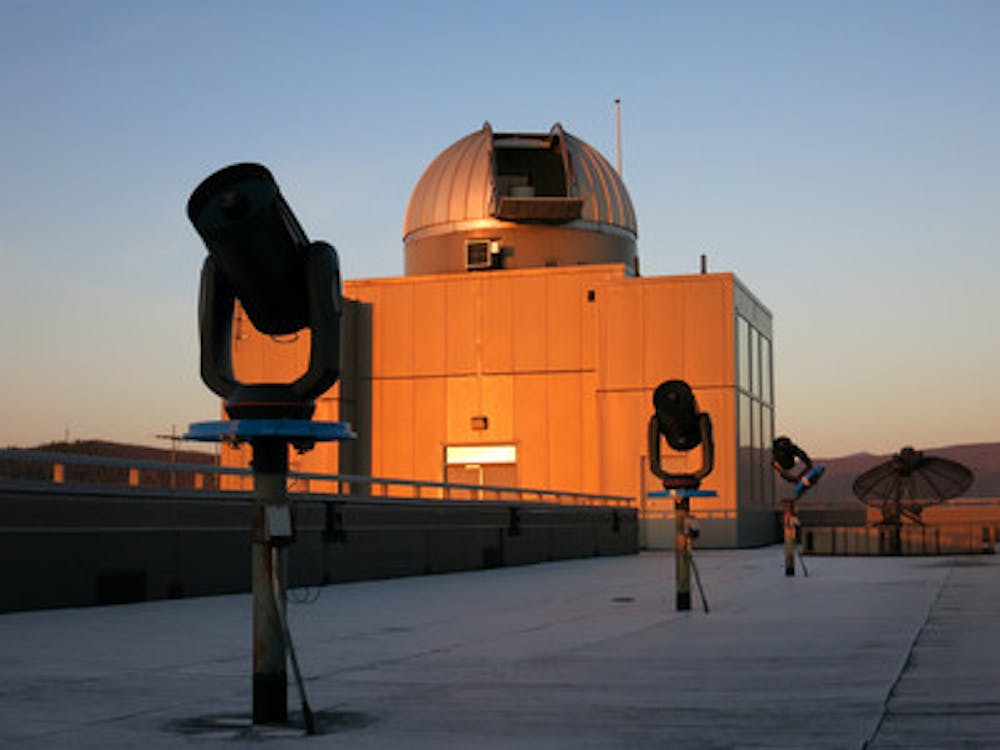One of the largest and highest quality telescopes in Vermont and its surrounding areas is on the roof of McCardell Bicentennial Hall. Luckily for Middlebury students, the telescope is made publicly available to students multiple times a semester. Observatory Night is a time for students and community members alike to come view the night sky through the large 24-inch telescope, through one of three smaller telescopes (one 8-inch, two 11-inch) or with the naked eye. During the event, telescope specialist Jonathan Kemp and the students who work with him are there to guide viewers around the sky and answer questions.
The Campus spoke with Mr. Kemp to talk about what Observatory Night is and its place in the college community.
“We have a really nice site here in the Champlain Valley,” Kemp said. “It’s quite dark … There are light pollution issues to consider in almost any site, but here in the Champlain Valley we’re at a pretty good dark site, we get some lovely clear nights.”
The telescope is one-of-a-kind in its architectural incorporation into the greater BiHall, Kemp said.
“One of the great things about the observatory here at McCardell Bicentennial Hall is that, when it was built, the observatory was designed as part of the building. In many science buildings, you’ll often find that the observatory is on the roof of the building but it’s often been an afterthought long after initial construction.”
The telescope is cared for in many unexpected ways; for example, the temperature in the dome is prudently regulated.
“What we like to do with an observatory dome is keep the temperature of the air in the dome itself as close as possible to the exterior temperature,” Kemp said. “A lot was done at construction and perhaps more importantly just after construction to minimize those thermal issues so that when we look through the telescope up there we get excellent image quality compared to some of our peer institutions that have similar large telescopes.”
The telescope and its controls were completely renovated and modernized in the summer of 2015. “It is now performing as well as it ever has,” Kemp said.
The combination of excellent technology and location allows students at Observatory Night to view celestial objects with remarkable clarity. When asked what his favorite thing is to look at in the night sky, Kemp could not pick just one. He highlighted the Orion Nebula in the winter sky and the Great Globular Cluster of Hercules (M13) in the summer sky as two of his favorites. He mentioned that Saturn and Jupiter are popular with students; the rings of Saturn are clearly visible through any of the telescopes. Additionally, it is possible to see the disk on the surface of Jupiter and its orbiting moons. Kemp even mentioned seeing the shadow of a moon on Jupiter’s surface.
These incredible sights tied into Kemp’s answer to my next question, in which he was asked what about Observatory Night would draw in a non-science major.
“I think the observatory can reach people on a variety of levels,” he said. “We find that people respond kind of viscerally to the night sky. When they look at [the night sky], especially when [they] look through a telescope for the first time at an object that [they have] never seen, that can be a very compelling thing. I think most importantly it kind of gives people an idea of their place within the universe. It makes them intellectually curious about the night sky, and, by extension, the universe, and the place of Man and the place of Earth within the universe.”
Kemp also mentioned that the team of students he works with includes history, economics and geology majors as well as physics majors.
“While [the Observatory] has physics at its core, it has threads that go through so many different disciplines. For someone who might be non-science major, it might satisfy their interest in the night sky or their interest in science if they don’t want to pursue a more formal curricular way.”
There are also opportunities for students who might be interested in working with him.
“I am always interested in students who have an interest in the observatory. I would always encourage students that have an interest to come talk to me.”
In all, Observatory Night offers a unique experience that should be on every student’s graduation bucket list. Towards the end of the conversation, Kemp spoke to the accessibility of the observatory.
“Since I arrived a little more than three years ago, we’ve been able to make the facility more available in a variety of ways on a variety of levels,” he said. “It’s been fantastic to see the interest in the observatory here. Learning about the night sky is something that I think we can stimulate here at the observatory, but by no means does that process of being engaged with the universe end here. Enjoying the night sky does not require a telescope. That process can continue once you leave the observatory”
For more information on and photographs taken by the telescope, visit go/observatory.




